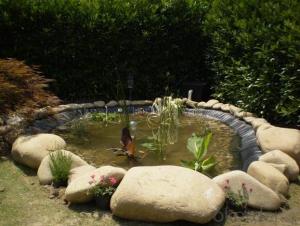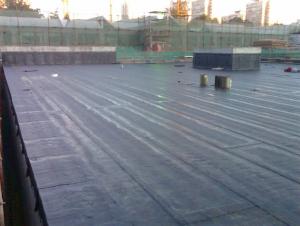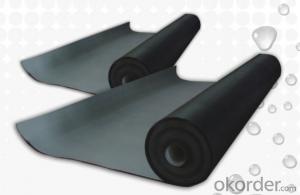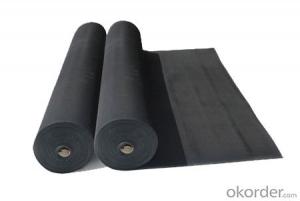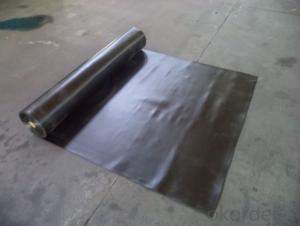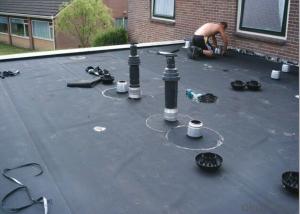EPDM Rubber Material Waterproof Membrane for Tall Building
- Loading Port:
- Shanghai
- Payment Terms:
- TT OR LC
- Min Order Qty:
- 50000 m²
- Supply Capability:
- 5000000 m²/month
OKorder Service Pledge
OKorder Financial Service
You Might Also Like
EPDM Rubber Material Waterproof Membrane for Tall Building
Description Of EPDM Rubber Material Waterproof Membrane for Tall Building:
This waterproof coiled material is of high elasticity with best performance among high polumer waterproof coiled material in the world.It is also the most typical one in the world.Waterproof coiled material made of ternary ethylene-propylene rubber is produced with the use of the most advanced contiuous extrusion and vulcanization technology and related equipments which are specially designed for production of such product.It is good in compactness,without bubble and performance difference in length and breadth,perfomances reach or exceed the demands of GB18173.1-2000 standard.
Main Features of EPDM Rubber Material Waterproof Membrane for Tall Building:
1.EPDM waterproof membrane for bridge engineering waterproof
2.EPDM waterproof membrane for water conservancy projects ,such as river bank,lake dam seepage.
3.EPDM waterproof membrane for the municipal engineering.
4.EPDM waterproof membrane for aquaculture.
Specifications of EPDM Rubber Material Waterproof Membrane for Tall Building:
| Number | Item | Unit | Value | |
| 1 | Size Variation | Thichness | % | ±10 |
| Width | % | ±1 | ||
| Length | % | Allowed negative | ||
| 2 | Breaking tensile strength at normal temperature | Mpa | ≥7.5 | |
| Breaking tensile strength at 70°C | Mpa | ≥2.3 | ||
| 3 | Breaking elongation at normal temperature | % | ≥450 | |
| Breaking elongation at -20°C | % | ≥200 | ||
| 4 | Tear strength | KN/m | ≥25 | |
| 5 | Impermeability(30min) | * | 0.3Mpa no leakage | |
| 6 | Bending at low tempreture | °C | ≤-40 | |
| 7 | Stretch tensor at heating | Elongate | mm | ≤2 |
| Shrink | mm | ≤4 | ||
| 8 | Air oven aging(80°C×168h) | Tensile strength at break retained | % | ≥80 |
| Elongation at break retained | % | ≥70 | ||
| 9 | Anti-alkali | Tensile strength at break retained | % | ≥80 |
| Elongation at break retained | % | ≥80 | ||
| 10 | Nuture weathing at manual simulation | Tensile strength at break retained | % | ≥80 |
| Elongation at break retained | % | ≥70 | ||
Applications of EPDM Rubber Material Waterproof Membrane for Tall Building:
Widely used in roofs, basement, toilet ,swimming pool, and all kinds of industry and civil building waterproofing, reservoir, vivicism, bridge, underground, tunnel and dam waterproofing ,especially to the keystone waterproofing projects which is durability, high corrosion resistance and easy deformation.



IMages of EPDM Rubber Material Waterproof Membrane for Tall Building:




FAQ of EPDM Rubber Material Waterproof Membrane for Tall Building:
1. What are we supplying?
We are specialized in producing Colorful Asphalt Roof Shingle, SBS/APP modified bitumen waterproof membrane, Self adhesive bitumen waterproof membrane, PVC waterproofing membrane, EPDM rubber roofing membrane, Single Component Polyurethane Waterproof Coating, and Spray Polyurea Waterproof Coating
.
2. How Many years experience do we have?
We have been exported to more than 20 countries in the past 15 years.
3. How long do we usually reply your request?
We always reply our customer within 24 hours.
- Q:How to choose waterproof membrane
- Third, from the physical quality of strict quality off From the appearance of visual inspection can only distinguish the composite tire coil, but failed to solve the selected products meet the quality requirements, which requires users to have the ability to test the technical institutions, according to the corresponding product standards for soluble content The physical properties of the factory test, with the soluble content of the project to control the product contains the amount of asphalt and modifier, but also to reveal the product used in the real face of the fetus can determine whether it is consistent with the product mark.
- Q:What is the difference between construction non-vulcanized waterproofing membrane and vulcanized waterproofing membrane?
- The advantages of the present invention Is: 1. elongation of permanent deformation is good, after stretching the rebound rate is small, no internal stress, can be fully adapted to the external factors caused by the deformation, there is no accelerated aging after the problem, so the service life can be improved 2-3 Times more than. 2. elongation, up to 1000%. 3. Natural vulcanization of a long time, can reach more than 10 years. 4. Good resistance to low temperature performance. 5. Bonding performance is good. 6. Production costs and operating costs are lower than other existing products.
- Q:Are waterproofing membranes resistant to alkalis?
- Yes, waterproofing membranes are generally resistant to alkalis.
- Q:How does a waterproofing membrane handle settlement or movement of the substrate?
- A waterproofing membrane is designed to handle settlement or movement of the substrate by providing flexibility and elasticity. It is typically made from materials such as modified bitumen, polyurethane, or acrylic polymers, which have the ability to stretch and contract without compromising the integrity of the membrane. When there is settlement or movement in the substrate, the waterproofing membrane can accommodate these changes by adjusting its shape and size accordingly. This prevents the membrane from cracking or tearing, which could lead to water infiltration and damage to the underlying structure. Additionally, some waterproofing membranes have reinforcing layers or fabrics embedded within them to enhance their strength and resistance to movement. These reinforcement layers help distribute stress and forces caused by settlement or movement, further protecting the membrane from potential damage. Furthermore, proper installation techniques are crucial to ensure the waterproofing membrane can effectively handle settlement or movement. The membrane should be applied in a continuous and seamless manner, using appropriate adhesives or fasteners to secure it to the substrate. This ensures that the membrane can flex and move with the substrate, rather than resisting or restricting its movements. In summary, a waterproofing membrane is designed to accommodate settlement or movement in the substrate by providing flexibility, elasticity, and reinforcement. Proper installation techniques are essential to ensure its effectiveness in handling these movements and maintaining a watertight barrier.
- Q:Can a waterproofing membrane be used on tunnels with security systems?
- Yes, a waterproofing membrane can be used on tunnels with security systems. The waterproofing membrane is designed to protect the tunnel structure from water infiltration and damage, and it can be installed without interfering with the security systems in place.
- Q:Does a waterproofing membrane provide any insulating properties?
- A waterproofing membrane does not offer any insulation. Its main purpose is to stop water or moisture from entering a building or roof. It acts as a protective barrier, preventing damage to the underlying materials. Insulation, on the other hand, is specifically designed to minimize the transfer of heat, sound, or electricity. While both waterproofing and insulation are crucial for maintaining a structure's integrity and functionality, they serve distinct purposes and should not be mistaken for each other.
- Q:Can a waterproofing membrane be used on underground structures?
- Yes, a waterproofing membrane can be used on underground structures. Waterproofing membranes are designed to provide a barrier against water infiltration and can be applied to various underground structures such as basements, tunnels, and foundations to prevent water damage and leakage.
- Q:What is a waterproofing membrane?
- A waterproofing membrane is a thin layer or sheet of material that is applied to a surface to prevent the passage of water or moisture. It is commonly used in construction, particularly in areas where water infiltration is a concern, such as roofs, basements, and bathrooms. The membrane acts as a barrier, preventing water from seeping through and causing damage to the underlying structure. It can be made from various materials, including rubber, bitumen, or synthetic polymers, and is typically applied in multiple layers to enhance its effectiveness. Waterproofing membranes are designed to be flexible, durable, and resistant to environmental factors such as UV radiation and temperature fluctuations. They are an essential component in ensuring the longevity and integrity of buildings by keeping them dry and protected from water-related issues like leaks, mold, and deterioration.
- Q:Are there any environmental considerations when using a waterproofing membrane?
- Yes, there are several environmental considerations when using a waterproofing membrane. Firstly, the production and disposal of these membranes can have a negative impact on the environment due to the energy and resources required. Additionally, the chemicals used in some waterproofing membranes can be harmful to the environment and may leach into the soil or water systems. It is important to choose eco-friendly and sustainable options, such as those made from recycled materials or natural alternatives, to minimize the environmental impact. Regular maintenance and proper disposal of the membrane at the end of its life cycle are also crucial to ensure minimal harm to the environment.
- Q:How does a waterproofing membrane handle hydrostatic pressure?
- A waterproofing membrane handles hydrostatic pressure by creating a barrier that prevents water from penetrating through it. It is designed to withstand the pressure exerted by water, ensuring that it remains intact and prevents any leakage or seepage.
1. Manufacturer Overview |
|
|---|---|
| Location | |
| Year Established | |
| Annual Output Value | |
| Main Markets | |
| Company Certifications | |
2. Manufacturer Certificates |
|
|---|---|
| a) Certification Name | |
| Range | |
| Reference | |
| Validity Period | |
3. Manufacturer Capability |
|
|---|---|
| a)Trade Capacity | |
| Nearest Port | |
| Export Percentage | |
| No.of Employees in Trade Department | |
| Language Spoken: | |
| b)Factory Information | |
| Factory Size: | |
| No. of Production Lines | |
| Contract Manufacturing | |
| Product Price Range | |
Send your message to us
EPDM Rubber Material Waterproof Membrane for Tall Building
- Loading Port:
- Shanghai
- Payment Terms:
- TT OR LC
- Min Order Qty:
- 50000 m²
- Supply Capability:
- 5000000 m²/month
OKorder Service Pledge
OKorder Financial Service
Similar products
New products
Hot products
Hot Searches
Related keywords
